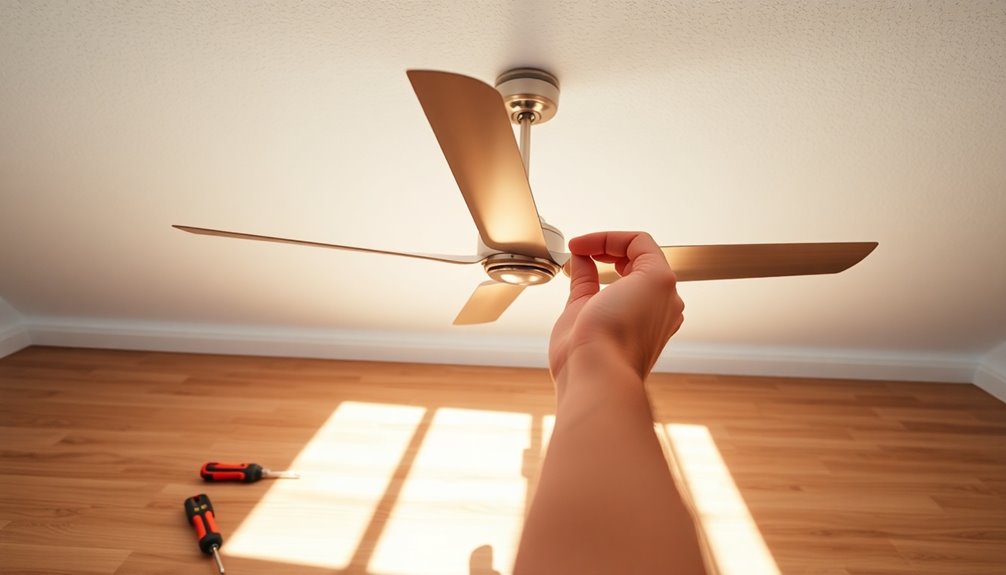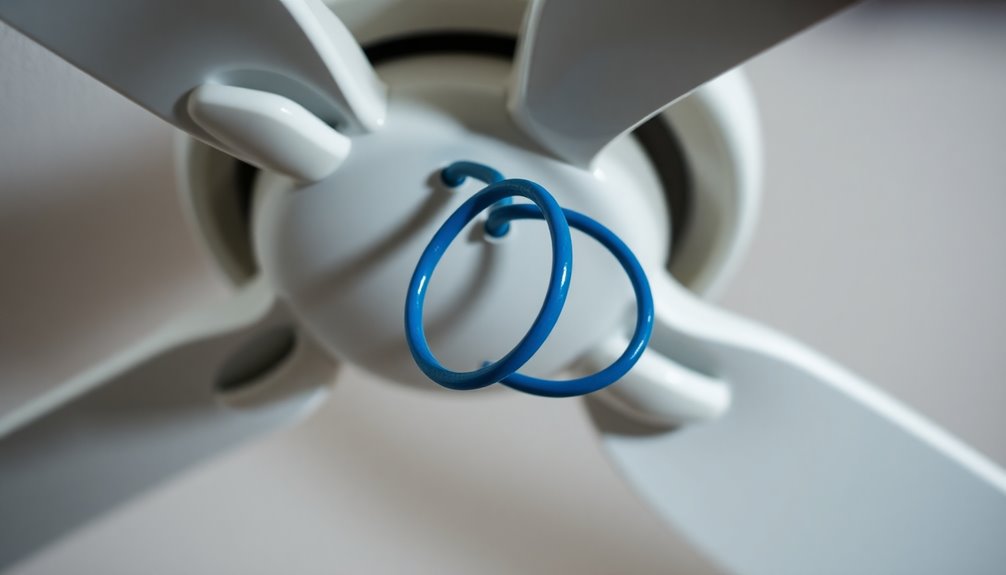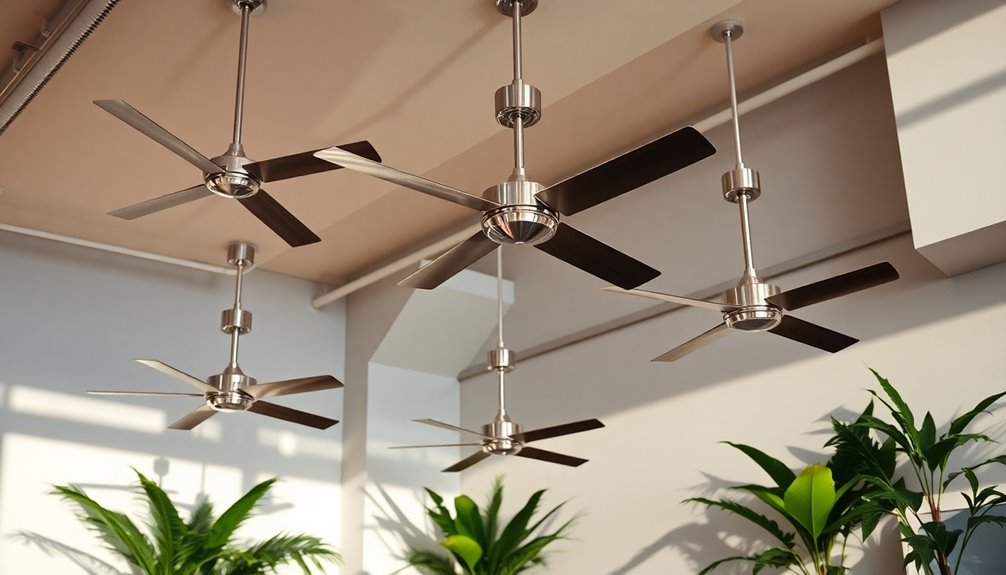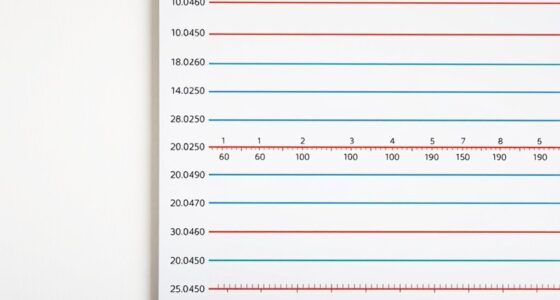Your ceiling fan should spin counterclockwise during the summer to create a cooling downdraft, making you feel cooler while allowing you to raise your thermostat setting. In winter, switch it to clockwise at a low speed to circulate warm air trapped near the ceiling. This simple adjustment can lower your heating costs by redistributing warmth effectively. Remember to turn off the fan before changing the direction and check your model's specific controls. Keeping these tips in mind not only enhances comfort but also boosts energy efficiency—stick around to discover more ways to optimize your fan's performance!
Key Takeaways
- In summer, set your ceiling fan to spin counterclockwise for a cooling downdraft effect.
- In winter, switch the fan to clockwise at low speed to circulate warm air effectively.
- Change fan direction during Daylight Savings Time: counterclockwise in spring and clockwise in fall.
- Use the pull chain, remote, or smart app to adjust the fan direction safely.
- Regularly maintain your fan by cleaning blades and checking for any loose parts to ensure efficiency.
Importance of Ceiling Fan Direction

The direction of your ceiling fan plays a pivotal role in your comfort and energy efficiency. By understanding how to adjust fan direction, you can optimize both cooling and heating in your home.
In summer, setting your fan to rotate counterclockwise creates a cooling downdraft, pushing cool air down and enhancing the wind chill effect. This allows you to raise your thermostat and still feel comfortable, saving on energy bills.
In contrast, during winter, you should switch your fan to a clockwise direction. This creates an updraft, redistributing warm air that tends to collect near the ceiling. By effectively circulating this warm air, you can improve heating efficiency and potentially reduce your heating costs by up to 15%.
Ignoring the correct ceiling fan direction can lead to inadequate airflow and discomfort. When your fan isn't set properly, your heating or cooling system works harder, leading to increased energy consumption.
Seasonal Guidelines for Fan Direction

When summer rolls in, you should set your ceiling fan to spin counterclockwise to create a revitalizing downdraft.
As winter approaches, flipping the direction to clockwise at a low speed helps warm air circulate more evenly in your space.
Summer Rotation Benefits
Maximizing comfort during the sweltering summer months involves using your ceiling fan to its full potential. To beat the summer heat, verify your ceiling fan spins counterclockwise. This direction creates a cooling downdraft, enhancing air circulation and producing a invigorating wind chill effect.
When your fan operates this way, you can comfortably raise your thermostat settings by up to 4 degrees without sacrificing comfort. By doing so, you'll not only enjoy a more comfortable home but also reduce energy costs considerably.
Running the fan at high speed can cut your overall energy expenses by up to 30% while decreasing your reliance on air conditioning. The cooling effect generated by the counterclockwise spin helps maintain a consistent room temperature and minimizes heat loss through ventilation systems.
To confirm your fan's direction, simply stand underneath it and feel for the air rushing down. If it's blowing downwards, you've got it right!
Embracing this summer rotation will help you create a invigorating and economical living space, making those hot days much more enjoyable.
Winter Rotation Advantages
As temperatures drop and you switch on your heating system, don't overlook the ceiling fan's role in maintaining a cozy atmosphere. By setting your ceiling fan direction to clockwise, you can create a gentle updraft that redistributes warm air that naturally rises to the ceiling back down into your living space.
Running the fan at a low speed not only enhances comfort but also allows for effective thermostat settings. This can potentially lower heating costs by up to 15%!
The clockwise rotation pushes warm air downward without creating cold drafts, ensuring a comfortable environment throughout your home.
Plus, this simple adjustment can greatly improve indoor air quality by increasing air exchanges as warm air circulates, preventing stale air from accumulating.
Utilizing your ceiling fan in winter doesn't just keep you warm; it leads to impressive energy savings. You can lower your thermostat settings by a few degrees and still feel cozy.
How to Change Fan Direction
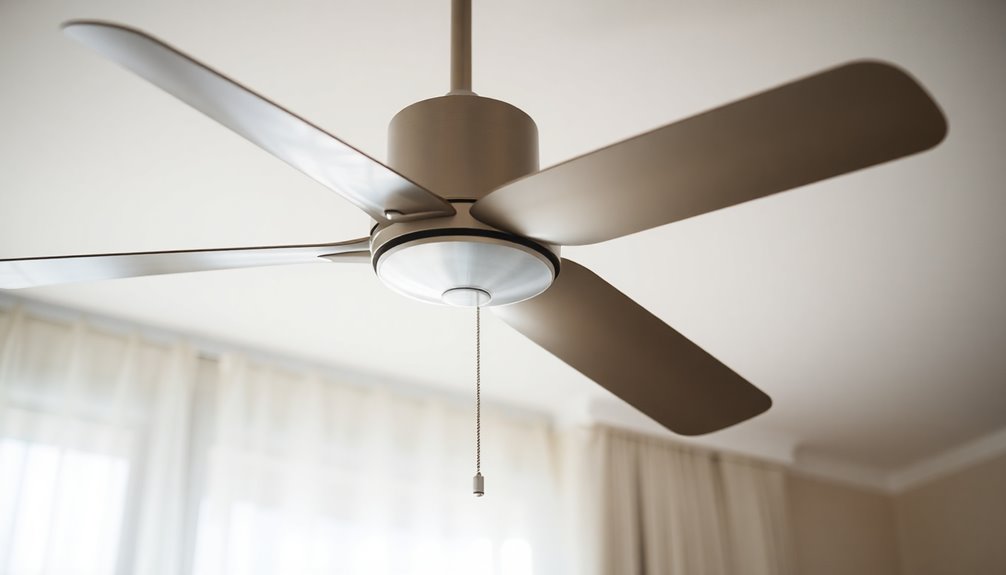
Changing your ceiling fan's direction is simple and can be done manually or with a remote control.
First, make certain the fan is off and has stopped completely.
Then, depending on your fan type, use the pull chain or remote to switch the direction and verify it's working properly afterward.
Manual Direction Change
Adjusting your ceiling fan's direction is a simple yet effective way to enhance your comfort throughout different seasons.
To change the direction, always start by turning off the fan and allowing it to come to a complete stop. This guarantees your safety while making adjustments.
If you have pull chain fans, locate the reversing switch on the fan body and toggle it to change the rotation direction. You'll notice the fan spinning in the opposite direction, perfect for either creating a cool breeze in summer or circulating warm air in winter.
If you have a remote-controlled fan, verify the remote is paired correctly. Press and hold the fan button until you see a blinking light, indicating the direction has changed.
You can also adjust smart fans using SIMPLEconnect® WiFi® technology or compatible voice commands through an app.
Once you've made the adjustments, turn the fan back on to confirm it operates correctly in the desired rotation direction.
Remote Control Adjustment
For remote-controlled ceiling fan direction changes, start by verifying the fan is completely off and stopped. This is essential for safety and effective adjustments.
Many remote-controlled fans feature a ceiling fan switch or a direction toggle button. Press and hold this button to switch the fan's rotation between clockwise and counterclockwise. You'll know you've successfully changed the ceiling fan direction when you see a blinking light on the remote.
If your handheld remote control isn't paired with the fan, check the manufacturer's instructions for the pairing process before proceeding.
For smart ceiling fans, you can change the fan direction using the corresponding app or by issuing voice commands compatible with your smart home system.
Once you've made the necessary adjustments, turn the fan back on to confirm it's operating in the desired fan direction.
This simple process guarantees your remote-controlled fan is set up just the way you like it, whether you're looking for a cooling breeze in the summer or a gentle warm air circulation in the winter.
Enjoy the comfort and convenience of your ceiling fan!
Timing for Direction Changes
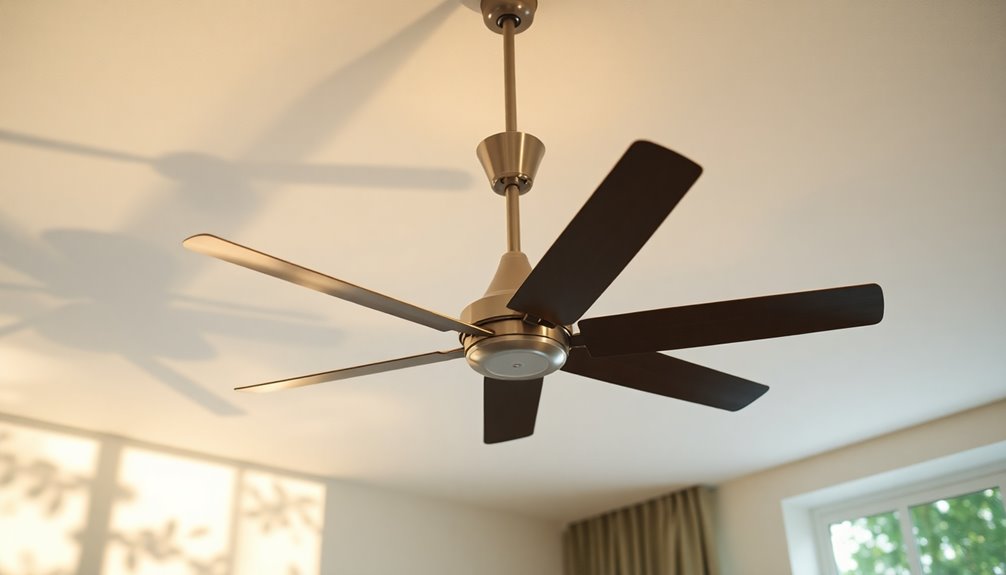
Timing your ceiling fan direction changes effectively can greatly enhance your comfort throughout the year.
One ideal time to make these changes is during Daylight Savings Time adjustments. When you spring forward, switch your ceiling fan's direction to counterclockwise to maximize airflow and keep your space cool in summer.
Conversely, when the clocks fall back in the fall, change your fan to spin clockwise. This helps circulate warm air during winter, improving your comfort levels.
Adjusting your fan direction seasonally can notably affect your energy costs, potentially reducing them by up to 30% in summer and 15% in winter.
To guarantee maximum efficiency, check the fan size for the room before making these changes. A properly sized fan will enhance airflow and help maintain the desired comfort levels in your living space.
Ceiling Fan Use in Different Rooms
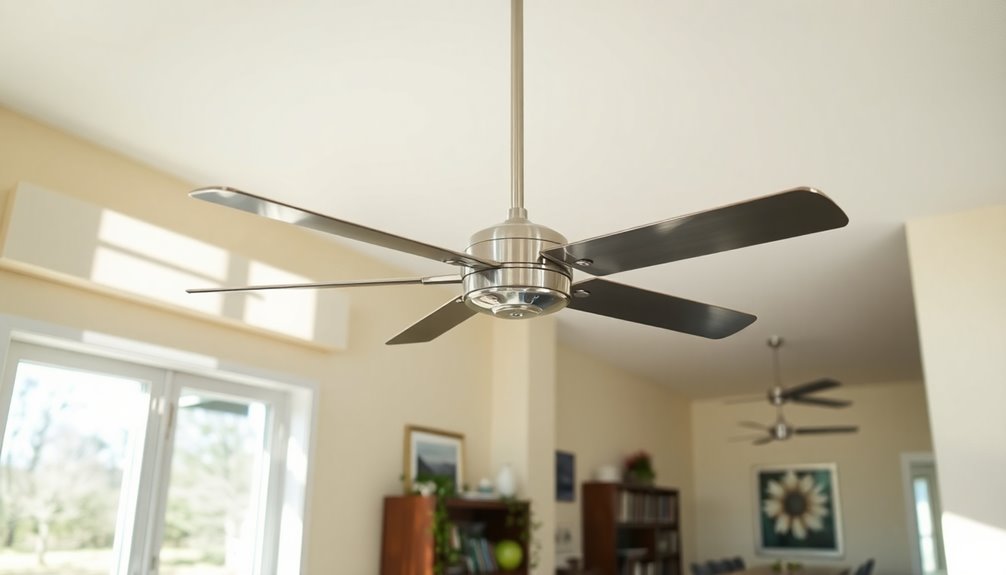
When it comes to ceiling fan use, the right settings can make a significant difference in comfort across various rooms of your home. Here's a quick guide to help you get the most out of your ceiling fans:
| Room | Direction | Purpose |
|---|---|---|
| Dining Room | Clockwise | Maintains comfort while cooling food slowly |
| Vaulted Ceilings | Counterclockwise | Minimizes wind chill effect year-round |
| Home Office | Clockwise | Gentle air circulation without blowing papers |
| Smoking Area | Clockwise | Draws smoke upward, improving air quality |
| Outdoor Spaces | Counterclockwise | Enhances airflow and keeps insects away |
In your dining room, set the ceiling fan to rotate clockwise at a medium to low speed, ensuring your meal stays warm. For vaulted ceilings, leave it counterclockwise to prevent excessive airflow. Medium clockwise is perfect in your home office, allowing air circulation without disrupting your work. If you smoke indoors, a clockwise direction helps draw the smoke away. Finally, outdoor fans should spin counterclockwise at high speed to maximize airflow and keep pests at bay.
Tips for Efficient Fan Operation

To make the most of your ceiling fan, it's essential to adjust its operation based on the season and room usage.
During summer, set your ceiling fan blades to spin counterclockwise at high speed to create a wind-chill effect, helping you keep cool. This allows you to raise your air conditioning thermostat, ultimately reducing your utility bills.
In winter, switch the fan to spin clockwise at a lower speed to circulate warm air that rises, maintaining a comfortable temperature in your home.
Remember to turn off ceiling fans in unoccupied rooms, as they cool people, not rooms. When you're in a space, however, pairing your ceiling fan with air conditioning can enhance cooling efficiency.
Regularly clean the fan blades and motor to guarantee peak airflow, as dust buildup can hinder performance.
Consider installing a remote control for convenient operation, enabling you to quickly change the fan's direction or speed as needed.
Frequently Asked Questions
Which Way Should a Ceiling Fan Spin to Cool a Room?
To effectively cool a room, you want your ceiling fan to spin counterclockwise. This direction creates a cooling downdraft, enhancing the wind chill effect and making you feel cooler without actually lowering the temperature.
When you stand directly under the fan, you should feel the air rushing down, confirming it's set correctly.
During the summer months, use a higher speed for maximum cooling efficiency, which can also help you save on energy costs.
Which Way Should a Ceiling Fan Turn in Summer Reddit?
So, you think your ceiling fan's just there for decoration, huh?
Well, it actually plays a big role in your comfort! In summer, you want it spinning counterclockwise. This way, it creates a invigorating downdraft that makes you feel cooler without dropping the room temperature.
Just stand under it; if you feel the air blowing down, it's doing its job. Adjust the speed to match your comfort level, and enjoy the breeze!
Should the Fan Switch Be up or Down for Summer?
For summer, you should set the fan switch to the down position.
This allows the fan to spin counterclockwise, creating an invigorating downdraft that cools your space. You'll feel the airflow directly beneath the fan, making the room feel up to 4 degrees cooler.
Plus, running it in this direction can help lower your energy costs by about 30%. So, make sure it's on high speed for ideal cooling!
How to Tell Fan Direction?
To tell the fan's direction, try testing the turbulent airflow.
If the blades spin counterclockwise, you'll feel an invigorating rush of coolness; if they spin clockwise, the air's stillness suggests warmth.
Simply stand beneath the fan and observe the blade's movement.
Many models feature a switch on the motor housing to change direction, so don't hesitate to flip it for seasonal comfort and enjoy that perfect breeze.
Conclusion
Ultimately, knowing the right direction for your ceiling fan can make your home feel cooler than a polar bear in a snowstorm during the sweltering summer months, while also keeping you cozy in winter. By adjusting the fan's direction seasonally and using it strategically in different rooms, you'll maximize comfort and efficiency. So, don't underestimate the power of that spinning blade overhead—it's your secret weapon for a perfectly climate-controlled home!

